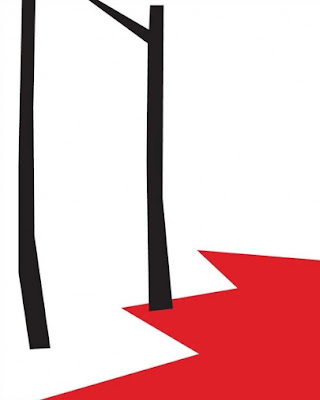John Baldessari started his career as a conceptual artist in the 1960s. In the 1980s he began taking found images from a trash cans in the back of a photography equipment stores. He also began to paint out areas and faces to make the characters non-identifiable, but the photograph still has a narrative. 
The show takes its name from Marshall McLuhan’s 1951 book, which examines the media landscape (press, radio, movies, ads) through discrete critical entries that could be read in any order.
Kurt Ralske is, ultimately, a high-tech sculptor of time, digitally manipulating given materials to evoke gorgeous visual texture and a stirring sense of dislocation.

John Carpenter involves projections of natural forms that gently pulse and flicker on their own but respond dynamically to the presence of viewers. -- Leah Ollman, LA Times
 Gerwald Rockenschaub, Untitled, 2007, Digital print on canvas, 19.7" x 27.6" x 1.2"
Gerwald Rockenschaub, Untitled, 2007, Digital print on canvas, 19.7" x 27.6" x 1.2"
 Gerwald Rockenschaub, Untitled, 2007, Digital print on canvas, 31.5" x 39.4" x 2"
Gerwald Rockenschaub, Untitled, 2007, Digital print on canvas, 31.5" x 39.4" x 2"
For more information (click here)

 The first time I heard of Steampunk, I was told the time period was 'when Victorians started integrating brown in their dress and environments'. The concept was 'how they envisioned the future'. Being from Seattle, I have always had an affinity for any sort of futurism. Upon further investigation, the time period is when Steam Power was commonly used and often located in Britain. --Krista Kelly
The first time I heard of Steampunk, I was told the time period was 'when Victorians started integrating brown in their dress and environments'. The concept was 'how they envisioned the future'. Being from Seattle, I have always had an affinity for any sort of futurism. Upon further investigation, the time period is when Steam Power was commonly used and often located in Britain. --Krista Kelly  The Edison Bar | Los Angeles
The Edison Bar | Los Angeles
(3 above images)
 Micah Ganske, Love Canal: Homes, Acrylic on Muslin, 15" x 16"
Micah Ganske, Love Canal: Homes, Acrylic on Muslin, 15" x 16"
 Micah Ganske, Centralia: Homes, Acrylic on Muslin, 15" x 16"
Micah Ganske, Centralia: Homes, Acrylic on Muslin, 15" x 16"

 Bill Owens, Suburbia Series, 1968-1970, California, USA
Bill Owens, Suburbia Series, 1968-1970, California, USA
For more information (click here)





















